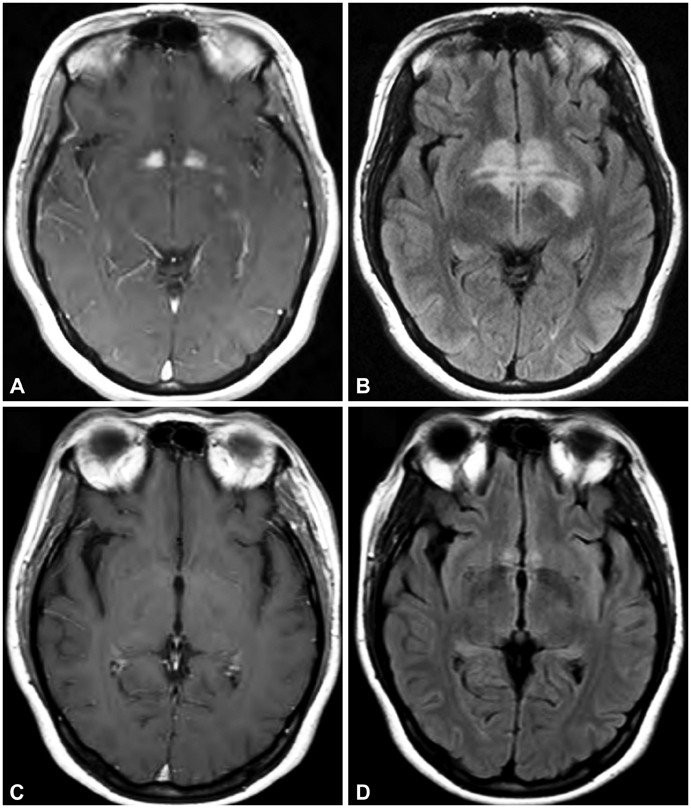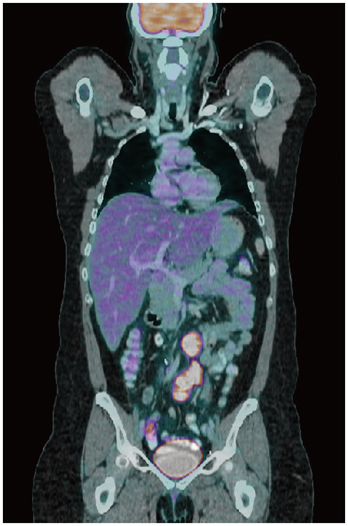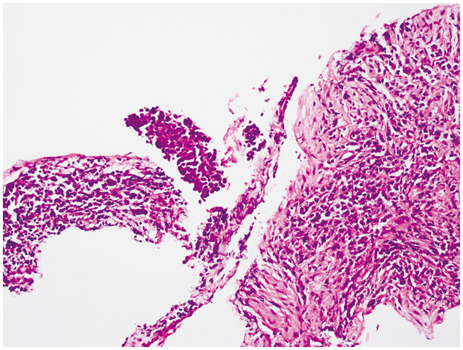J Clin Neurol.
2014 Jul;10(3):262-266. 10.3988/jcn.2014.10.3.262.
Anti-Ma2 Paraneoplastic Encephalitis in Association with Recurrent Cervical Cancer
- Affiliations
-
- 1Departments of Neurology and Neurosurgery, University of Colorado School of Medicine, Aurora, CO, USA. Douglas.Ney@ucdenver.edu
- 2Division of Medical Oncology, University of Colorado School of Medicine, Aurora, CO, USA.
- 3Division of Gynecologic Oncology, University of Colorado School of Medicine, Aurora, CO, USA.
- KMID: 2179455
- DOI: http://doi.org/10.3988/jcn.2014.10.3.262
Abstract
- BACKGROUND
Paraneoplastic neurological syndromes are rare, and although they are frequently associated with gynecological malignancies, cervical cancer is a rare cause. The symptoms of anti-Ma2 encephalitis are diverse and often present prior to the diagnosis of malignancy.
CASE REPORT
We report a case of a 37-year-old woman with a history of cervical cancer presenting with unexplained weight gain and vertical supranuclear gaze palsy. Magnetic resonance imaging of the brain revealed lesions within the bilateral hypothalami and midbrain. Anti-Ma2 antibodies were eventually found in the serum, prompting a search for malignancy. Recurrent metastatic cervical cancer was found in the retroperitoneal lymph nodes.
CONCLUSIONS
This is the first report of cervical cancer in association with anti-Ma2 encephalitis, and highlights the need for a high degree of suspicion in patients with a cancer history presenting with neurological symptoms. The symptoms associated with anti-Ma2 encephalitis are diverse and typically precede the diagnosis of cancer in patients, and should trigger a search for an underlying malignancy.
MeSH Terms
Figure
Reference
-
1. Voltz R, Gultekin SH, Rosenfeld MR, Gerstner E, Eichen J, Posner JB, et al. A serologic marker of paraneoplastic limbic and brain-stem encephalitis in patients with testicular cancer. N Engl J Med. 1999; 340:1788–1795.
Article2. Graus F, Delattre JY, Antoine JC, Dalmau J, Giometto B, Grisold W, et al. Recommended diagnostic criteria for paraneoplastic neurological syndromes. J Neurol Neurosurg Psychiatry. 2004; 75:1135–1140.
Article3. Ahern GL, O'Connor M, Dalmau J, Coleman A, Posner JB, Schomer DL, et al. Paraneoplastic temporal lobe epilepsy with testicular neoplasm and atypical amnesia. Neurology. 1994; 44:1270–1274.
Article4. Dalmau J, Graus F, Villarejo A, Posner JB, Blumenthal D, Thiessen B, et al. Clinical analysis of anti-Ma2-associated encephalitis. Brain. 2004; 127(Pt 8):1831–1844.
Article5. Hoffmann LA, Jarius S, Pellkofer HL, Schueller M, Krumbholz M, Koenig F, et al. Anti-Ma and anti-Ta associated paraneoplastic neurological syndromes: 22 newly diagnosed patients and review of previous cases. J Neurol Neurosurg Psychiatry. 2008; 79:767–773.
Article6. Adams C, McKeon A, Silber MH, Kumar R. Narcolepsy, REM sleep behavior disorder, and supranuclear gaze palsy associated with Ma1 and Ma2 antibodies and tonsillar carcinoma. Arch Neurol. 2011; 68:521–524.
Article7. Darnell RB, Posner JB. Paraneoplastic Syndromes. New York: Oxford University Press;2011.8. Johannis W, Renno JH, Wielckens K, Voltz R. Ma2 antibodies: an evaluation of commercially available detection methods. Clin Lab. 2011; 57:321–326.9. Okagbue UE, Wang LY, Cymet T, Rabin B, Erlich RB. A rare case of anti-Hu paraneoplastic neurologic syndrome in association with cervical cancer. Compr Ther. 2008; 34:48–50.10. Power DG, McVey GP, Delaney DW, Rea D, D'arcy T, Daly PA, et al. Papillary serous carcinomas of the uterine cervix and paraneoplastic cerebellar degeneration: a report of two cases. Acta Oncol. 2008; 47:1590–1593.
Article11. Sutton GP, Siemers E, Stehman FB, Ehrlich CE. Eaton-Lambert syndrome as a harbinger of recurrent small-cell carcinoma of the cervix with improvement after combination chemotherapy. Obstet Gynecol. 1988; 72(3 Pt 2):516–518.12. Darnell RB, Posner JB. Paraneoplastic syndromes involving the nervous system. N Engl J Med. 2003; 349:1543–1554.
Article13. Linke R, Schroeder M, Helmberger T, Voltz R. Antibody-positive paraneoplastic neurologic syndromes: value of CT and PET for tumor diagnosis. Neurology. 2004; 63:282–286.
Article
- Full Text Links
- Actions
-
Cited
- CITED
-
- Close
- Share
- Similar articles
-
- Anti-Ma2-Associated Encephalitis Presenting as Hypersomnia
- Anti-Ma2-Associated Encephalitis with Axonal Sensorimotor Polyneuropathy
- Coexistence of Anti-Hu and Anti-SOX1 Autoantibodies in Atezolizumab-related Encephalitis
- Paraneoplastic Encephalitis Associated with Locally Advanced Human Epidermal Growth Factor Receptor 2-Positive Breast Cancer
- Anti-Yo-associated autoimmune encephalitis after colon cancer treatment




